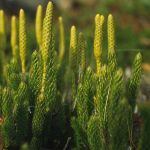| Common Name: |
Ground Pine |
| Other Names: |
Stag's Horn Club Moss |
| Botanical Name: |
Lycopodium clavatum |
| Genus: |
Lycopodium |
| Family: |
Lycopodiaceae |
| Cultivation: |
Damp, acid soil in sun or shade. |
| Propagation: |
By spores sown on damp sphagnum moss; by layering at any time. |
| Harvest: |
Plants are cut all year round and used fresh, or dried for use in decoctions and infusions. Spores are shaken out into a sieve from plants cut in summer. |
| Native Location: |
Native to alpine and arctic zones of both hemispheres, and montane areas in temperate and tropical regions. |
| Height: |
12cm (5in) |
| Width: |
1m (3ft) |
| Hardiness: |
Z2-8 |
| Parts Used: |
Whole plant (shen jin cao), spores. |
| Properties: |
A sedative, anti-bacterial herb that is diuretic, lowers fever, benefits the digestion, and stimulates the uterus. |
| Medicinal Uses: |
Internally for urinary and kidney disorders, catarrhal cystitis, gastritis, and in Chinese medicine for rheumatoid arthritis and traumatic injury. Externally for skin diseases and irritation. Spores are the basis for a homeopathic preparation for dry coughs, rheumatic pains, mumps, and complaints that characteristically cause pain or discomfort on the right side of the body. |
| Bibliography: |
Encyclopedia of Herbs by Deni Brown. Copyright © 1995, 2001 Dorling Kindersley Limited. pg 268
|

